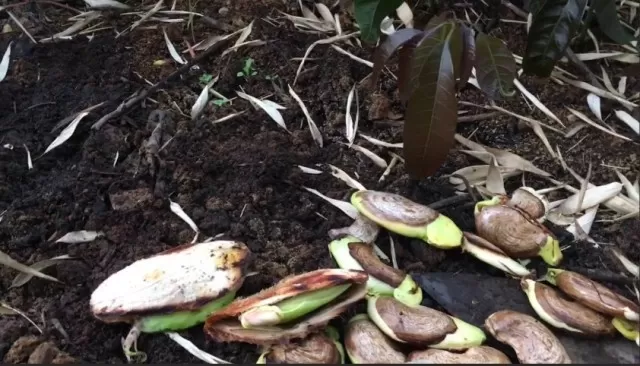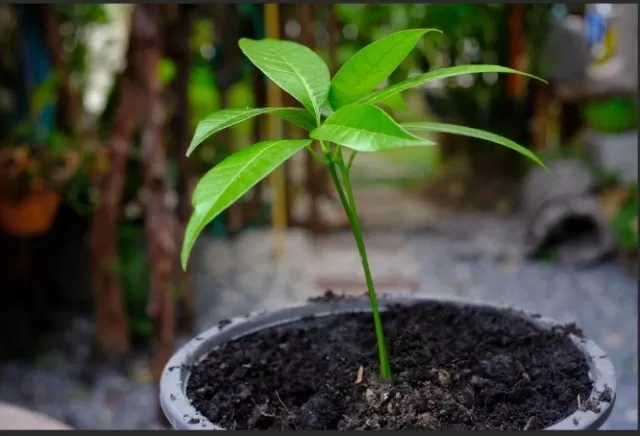From Seed to Tree: A Comprehensive Guide to Growing Mangoes.The next time you relish a juicy mango, don’t discard the seed – it’s your ticket to cultivating your very own mango tree. While it can be a bit of a challenge, growing mango seedlings is a rewarding endeavor that can be done in containers or outdoors. Growing your own mango tree can be a gratifying experience, and it’s a great way to enjoy the sweet rewards of homegrown fruit. With patience, care, and attention to their specific needs, you can nurture your mango seedling into a thriving tree that yields delicious mangoes for years to come.
Shade-Grown Lettuce: A Cool Way to Prolong Freshness

Growing lettuce in shaded areas offers a distinct advantage: it significantly extends its lifespan by ensuring that its roots remain comfortably cool.
When you choose to plant this mineral-rich leafy green during the spring and fall seasons, success hinges on selecting a loose, well-draining, and nutrient-rich soil. To get started, sow lettuce seeds about 1/4-inch deep and keep them spaced approximately 1 inch apart, delicately covering them with a light dusting of soil.
The beauty of lettuce lies in its ability to be harvested at various stages of growth.
Whether you prefer the delicate charm of baby leaves, typically measuring between 3 to 6 inches in size, or the fully matured heads that develop in roughly 50 days from seeding, lettuce provides a range of choices to suit your culinary needs.
For the freshest lettuce experience, consider harvesting it in the early morning when temperatures are mild, and the leaves are infused with moisture.
Swiftly refrigerate your harvest, as cut leaves can wilt in as little as 15 minutes, ensuring that your salads and dishes maintain that crisp, garden-fresh goodness.
Shade-Grown Spinach: A Shortcut to Vitamin-Rich Bliss
Harnessing the power of shade, you can cultivate vitamin-packed spinach with accelerated growth and the added benefit of preventing plant bolting, which can lead to the unwelcome bitterness of the leaves.
Spinach, a cool-weather favorite, finds its ideal planting time in the late winter to early spring. To create the perfect growing environment, opt for nutrient-rich soil enhanced with compost, ensuring excellent drainage. In warmer climates, a layer of mulch proves invaluable for retaining moisture and keeping your spinach plants comfortably cool.
To initiate your spinach adventure, sow seeds about 1/2-inch deep in either a container or Garden Bed, generously spacing them at 2-inch intervals.
Gently cover the seeds with a 1/2-inch layer of soil. For a continuous harvest of this leafy delight, make it a habit to sow new seeds every two to three weeks.
When it comes to reaping the rewards of your spinach crop, timing is everything.
Harvest your spinach as soon as the baby leaves reach a petite 2 to 3 inches in size for the mildest and most tender flavor. Alternatively, wait for maturity to be reached, which typically occurs between 28 to 55 days from the initial seeding.
When it’s time, carefully cut the heads at ground level to maximize your yield. Keep in mind that bitterness can take hold if you delay your harvest beyond the point of maturity, so swift and timely picking is key to savoring the exquisite taste of your homegrown spinach.
Thriving Beets: A Shade-Tolerant, Fiber-Packed Crop

Beets, the champions of fiber, offer a swift-growing addition to your garden that can thrive even in shady conditions and endure near-freezing temperatures.
To embark on a successful beet-growing journey, kickstart your planting in the early spring as soon as the soil becomes workable. These versatile vegetables have a particular fondness for loose, compost-rich, and well-drained soil.
To maintain optimal growing conditions, consider applying a protective layer of organic mulch, like straw or wood chips, around the base of your beet plants. This not only keeps weeds at bay but also helps stabilize soil temperature fluctuations.
When it’s time to sow your beet seeds, remember to plant them approximately 1/2-inch deep, with a generous 2-inch spacing between each seed.
You can choose between deep containers or garden beds, depending on your space and preferences.
The beauty of cultivating beets lies in their quick maturation.
You can expect to start harvesting these earthy delights in just seven to nine weeks. Look for the telltale sign of readiness: beet crowns protruding 1 to 2 inches above the soil line.
At this point, you can pluck them from the earth and enjoy the sweet, earthy flavor of your homegrown beets in a variety of culinary delights.
Radishes Unveiled: Cultivating Vitamin-Rich Delights with Care
Radishes, brimming with essential vitamins, can be a delightful addition to your garden, but they require some careful consideration when it comes to light and shade.
Unlike other crops, excessive heat and direct sunlight can cause these nutritious gems to bolt, leading to undesirable woody or pithy textures. In contrast, strategically placed shade shields radishes from such fate, ensuring their succulence.
For a successful radish harvest, aim to plant them in either the spring or fall, providing them with a loose, well-drained soil enriched with organic matter.
When sowing radish seeds, bury them approximately 1/2 inch into the ground, maintaining a spacing of around 2 inches apart. You can opt for garden beds or deep containers, depending on your gardening setup.
Radishes are known for their rapid growth, and you can expect them to reach their prime size of 1 to 2 inches in just three to four weeks after sowing.
To foster their growth, ensure they receive six to eight hours of daily sunlight.
Proper hydration is essential for your radishes.
Keep the soil consistently moist, but avoid overwatering to prevent waterlogged conditions. Water at the base of the plants, as overhead watering may lead to fungal diseases.
When it comes to radish varieties, you have a plethora of options to explore, such as Cherry Belle, French Breakfast, Easter Egg, Watermelon Radish, Daikon, Black Spanish, German Giant, White Icicle, and Cherriette.
Each offers a unique flavor and appearance to elevate your culinary creations.
Interestingly, bolting isn’t always a drawback when it comes to radishes.
These resilient plants produce phlox-like flowers that can later yield tasty seed pods, providing an additional dimension to your radish-growing experience.
Arugula Unveiled: Cultivating a Folate-Rich Green with Careful Sunlight Management

Arugula, a speedy grower brimming with folate, offers a delightful addition to your garden, but it demands mindful consideration when it comes to sunlight.
Excessive sun exposure can impart a bitter taste to this vibrant green, which you can plant with success in both the spring and fall seasons. To ensure your arugula thrives, it craves a loose, compost-rich, and well-drained soil.
In warmer climates, applying mulch serves as a valuable ally, keeping the plant cool while retaining essential moisture.
To guarantee a continuous supply of arugula leaves throughout the growing season, consider succession sowing directly into your garden bed.
Plant the seeds approximately 1/4-inch deep and space them 12 to 18 inches apart. This strategic approach ensures a steady stream of tender and flavorful leaves to grace your culinary creations.
The secret to savoring the best of arugula lies in harvesting the leaves when they are at their tender and youthful peak.
Clip individual leaves when they reach a modest 2 to 3 inches in length for an uninterrupted supply of this peppery delight. Alternatively, you can opt to cut the entire plant at its base when the time is right.
This careful approach guarantees that your arugula maintains its delectable flavor and enriches your dishes with its unique zest.
*The information is for reference only.